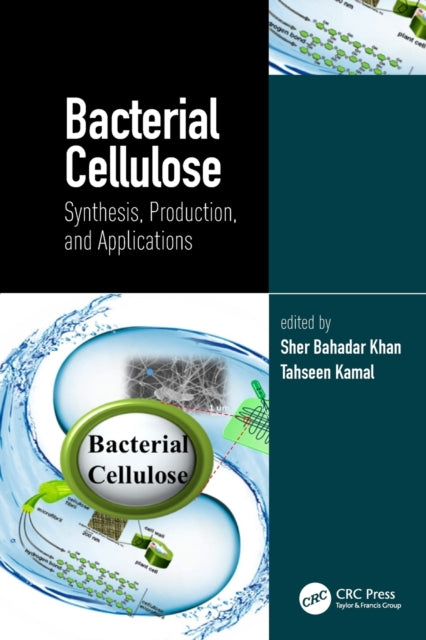Shulph Ink
Bacterial Cellulose: Synthesis, Production, and Applications
Bacterial Cellulose: Synthesis, Production, and Applications
YOU SAVE £2.21
- Condition: Brand new
- UK Delivery times: Usually arrives within 2 - 3 working days
- UK Shipping: Fee starts at £2.39. Subject to product weight & dimension
Bulk ordering. Want 15 or more copies? Get a personalised quote and bigger discounts. Learn more about bulk orders.
Couldn't load pickup availability
- More about Bacterial Cellulose: Synthesis, Production, and Applications
Bacterial cellulose (BC) is a natural polymer with unique properties for various applications, including biomedical, electronics, energy, and environmental fields. This book provides an overview of BC synthesis, characterization, modification, and application, including composites and aerogels, development from waste, and challenges in large-scale production.
Format: Paperback / softback
Length: 230 pages
Publication date: 01 October 2021
Publisher: Taylor & Francis Ltd
Bacterial cellulose (BC) is a natural polymer produced by various microbial cells, exhibiting unique structural, physico-chemical, mechanical, thermal, and biological properties that make it highly valuable for diverse applications in the biomedical, electronics, energy, and environmental fields. This text provides a comprehensive overview of the synthesis, characterization, modification, and application of BC.
Sources and Characterization of BC: BC is produced by a variety of microbial species, including Gluconacetobacter xylinus, Agrobacterium tumefaciens, and Komagataeibacter xylinus. These bacteria produce cellulose fibers through a process called fermentation, which involves the breakdown of glucose into cellulose. The resulting fibers are characterized by their high purity, high crystallinity, and high tensile strength.
Biosynthesis of BC: The biosynthesis of BC begins with the production of glucose by photosynthesis. The glucose is then converted into glucose-6-phosphate by the enzyme glucose-6-phosphate isomerase. This glucose-6-phosphate is then used as a substrate for the production of cellulose by the enzyme cellulose synthase. The cellulose synthase enzyme is composed of several subunits, including the catalytic subunit, the regulatory subunit, and the scaffolding subunit.
Composites and Aerogels Based on BC: BC can be used to create composites and aerogels. Composites are materials that are made by combining two or more materials, while aerogels are materials that are made by trapping air in a gel-like structure. BC can be used to create composites that are stronger, lighter, and more durable than traditional materials, while aerogels can be used to create materials that are highly insulating and lightweight.
Development of BCs from Waste: BC can be produced from waste materials, such as agricultural waste, municipal waste, and industrial waste. This process involves the fermentation of the waste materials, followed by the extraction of the cellulose fibers. The extracted cellulose fibers can then be used to create composites and aerogels.
Challenges in Large-Scale Production of BCs: The large-scale production of BCs is challenging due to the need for large amounts of glucose, the need for specialized equipment, and the need for controlled fermentation conditions. Additionally, the production of BCs can have negative environmental impacts, such as the release of greenhouse gases and the use of large amounts of water.
Applications of BC: BC has a wide range of applications in the biomedical, electronics, energy, and environmental fields. In the biomedical field, BC is used to create medical devices, such as wound dressings, implants, and drug delivery systems. In the electronics field, BC is used to create electronic devices, such as touchscreens, batteries, and sensors. In the energy field, BC is used to create biofuels and to create energy-efficient buildings. In the environmental field, BC is used to create biodegradable packaging, to create soil amendments, and to create water purification systems.
Conclusion: Bacterial cellulose is a natural polymer that exhibits unique structural, physico-chemical, mechanical, thermal, and biological properties that make it highly valuable for diverse applications in the biomedical, electronics, energy, and environmental fields. This text provides a comprehensive overview of the synthesis, characterization, modification, and application of BC, and it will be of great interest to researchers and industry professionals in materials science, chemical engineering, chemistry, and other related fields seeking to learn about the synthesis and application of this important material.
Weight: 358g
Dimension: 154 x 233 x 16 (mm)
ISBN-13: 9780367633134
This item can be found in:
UK and International shipping information
UK and International shipping information
UK Delivery and returns information:
- Delivery within 2 - 3 days when ordering in the UK.
- Shipping fee for UK customers from £2.39. Fully tracked shipping service available.
- Returns policy: Return within 30 days of receipt for full refund.
International deliveries:
Shulph Ink now ships to Australia, Belgium, Canada, France, Germany, Ireland, Italy, India, Luxembourg Saudi Arabia, Singapore, Spain, Netherlands, New Zealand, United Arab Emirates, United States of America.
- Delivery times: within 5 - 10 days for international orders.
- Shipping fee: charges vary for overseas orders. Only tracked services are available for most international orders. Some countries have untracked shipping options.
- Customs charges: If ordering to addresses outside the United Kingdom, you may or may not incur additional customs and duties fees during local delivery.


